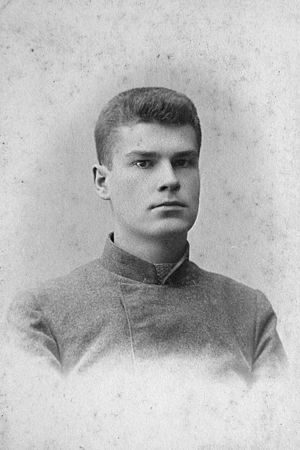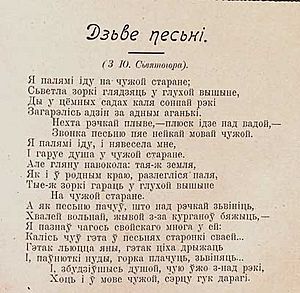Maksim Bahdanovič facts for kids
Quick facts for kids
Maksim Bahdanovich
|
|
|---|---|
 |
|
| Native name |
Максім Багдановіч
|
| Born | 9 December 1891 Minsk, Minsk Governorate, Russian Empire (now Belarus) |
| Died | 25 May 1917 (aged 25) Yalta, Taurida Governorate, Russia (now Ukraine) |
| Pen name | Maksim Knizhnik (Максім Кніжнік) |
| Occupation | poet, publicist, translator, literary critic |
| Period | 1907-1917 |
| Genre | verse, poem |
| Literary movement | Impressionism, symbolism |
Maksim Adamavič Bahdanovič (Belarusian: Максім Адамавіч Багдановіч; 9 December 1891 – 25 May 1917) was a famous Belarusian poet. He was also a journalist, a translator, and a literary critic. Many people see him as one of the most important people who helped create modern Belarusian literature.
Contents
Maksim Bahdanovich's Life Story
Maksim Bahdanovič was born in Minsk. His father, Adam Bahdanovič, was a well-known Belarusian expert on culture and traditions. His father worked mostly as a bank clerk. Maksim's family lived in an apartment near Trinity Hill.
In 1892, Maksim's family moved to Hrodna. His father got a job at a local bank there. Sadly, Maksim's mother, Maria, died in 1896 from tuberculosis.
In 1896, Adam Bahdanovič moved with his children to Nizhny Novgorod, Russia. Around this time, Maksim wrote his very first poems in the Belarusian language. In 1902, Bahdanovič started attending a high school called a gymnasium. During the Revolution of 1905, he actively joined in strikes with his classmates.
In 1907, a newspaper called Nasha Niva published Bahdanovič's first work. It was a story called Muzyka.
In June 1908, Maksim's family moved to Yaroslavl'. After finishing school in 1911, Bahdanovič visited Belarus. He wanted to meet important people from the Belarusian Renaissance. This was a time when Belarusian culture and language were becoming very popular again.
In the same year, he started studying law at a school in Yaroslavl. While studying, Bahdanovič also worked at a newspaper. He wrote many literary works and had them published in both Belarus and Russia.
In early 1914, his only book of poems was published in Vilna (which is now Vilnius). The book was called Vianok, which means A Wreath.
In the summer of 1916, after finishing his studies, Maksim Bahdanovič moved to Minsk. He worked there in a local government office.
In February 1917, Bahdanovič traveled to Crimea to get treatment for tuberculosis. Sadly, the treatment did not work. He died that year in Yalta.
Maksim's writings and papers were kept at his father's house. However, many of them were damaged during the Russian Civil War in 1918.
Maksim Bahdanovich's Impact on Belarusian Literature
Between 1991 and 1995, a complete collection of Bahdanovich's poems was published in Belarus.
Today, you can visit museums dedicated to the poet in Minsk (Maksim Bahdanovič Literary Museum), Hrodna, and Yaroslavl'. Several streets in major cities in Belarus and Russia are named after him.
His works have even been turned into operas. These include Zorka Venera and Maksim.
Bahdanovich wrote many poems about society, art, and deep thoughts. He was the first poet to bring new ways of writing poetry to Belarusian literature.
Maksim Bahdanovich was also a talented translator. He translated works by famous poets like Paul Verlaine and Heinrich Heine into Belarusian. He also translated works by Belarusian poets like Janka Kupala into Russian.
Maksim Bahdanovich's Famous Work
In 1916, Maksim Bahdanovič wrote a well-known poem called "Pahonia". A Belarusian composer named Nikolay Shcheglov-Kulikovich later wrote music for it. The song was first meant to be sung without instruments. Other composers also created their own music for the poem.
In the early 1990s, Shcheglov-Kulikovich’s version was considered as a possible national anthem for Belarus. In 2020, a choir and orchestra recorded a new version of the anthem.
In 2020, the "Pahonia" anthem and poem became very popular again. It was used as a symbol during the 2020 Belarusian protests against the government. The poem and the white-red-white flag became important symbols for people wanting change. The anthem was sung in many public places. These included the Belarusian State Philharmonia, shopping malls, the Minsk subway, and the Minsk railway station.
Images for kids
See also
 In Spanish: Maksim Bahdanovič para niños
In Spanish: Maksim Bahdanovič para niños



